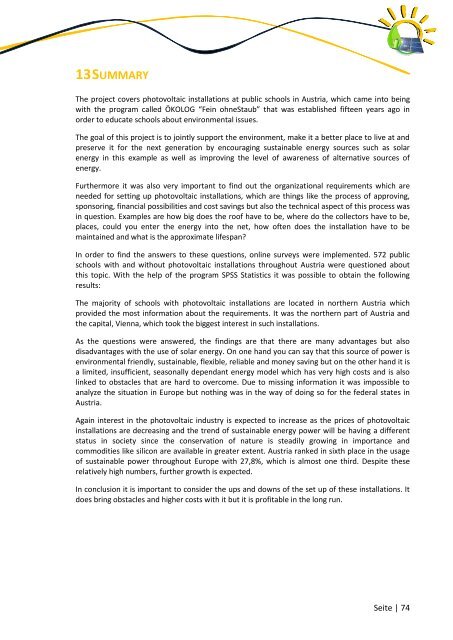VerfasserInnen: Betreuerinnen:
Sie wollen auch ein ePaper? Erhöhen Sie die Reichweite Ihrer Titel.
YUMPU macht aus Druck-PDFs automatisch weboptimierte ePaper, die Google liebt.
13 SUMMARY<br />
The project covers photovoltaic installations at public schools in Austria, which came into being<br />
with the program called ÖKOLOG “Fein ohneStaub” that was established fifteen years ago in<br />
order to educate schools about environmental issues.<br />
The goal of this project is to jointly support the environment, make it a better place to live at and<br />
preserve it for the next generation by encouraging sustainable energy sources such as solar<br />
energy in this example as well as improving the level of awareness of alternative sources of<br />
energy.<br />
Furthermore it was also very important to find out the organizational requirements which are<br />
needed for setting up photovoltaic installations, which are things like the process of approving,<br />
sponsoring, financial possibilities and cost savings but also the technical aspect of this process was<br />
in question. Examples are how big does the roof have to be, where do the collectors have to be,<br />
places, could you enter the energy into the net, how often does the installation have to be<br />
maintained and what is the approximate lifespan?<br />
In order to find the answers to these questions, online surveys were implemented. 572 public<br />
schools with and without photovoltaic installations throughout Austria were questioned about<br />
this topic. With the help of the program SPSS Statistics it was possible to obtain the following<br />
results:<br />
The majority of schools with photovoltaic installations are located in northern Austria which<br />
provided the most information about the requirements. It was the northern part of Austria and<br />
the capital, Vienna, which took the biggest interest in such installations.<br />
As the questions were answered, the findings are that there are many advantages but also<br />
disadvantages with the use of solar energy. On one hand you can say that this source of power is<br />
environmental friendly, sustainable, flexible, reliable and money saving but on the other hand it is<br />
a limited, insufficient, seasonally dependant energy model which has very high costs and is also<br />
linked to obstacles that are hard to overcome. Due to missing information it was impossible to<br />
analyze the situation in Europe but nothing was in the way of doing so for the federal states in<br />
Austria.<br />
Again interest in the photovoltaic industry is expected to increase as the prices of photovoltaic<br />
installations are decreasing and the trend of sustainable energy power will be having a different<br />
status in society since the conservation of nature is steadily growing in importance and<br />
commodities like silicon are available in greater extent. Austria ranked in sixth place in the usage<br />
of sustainable power throughout Europe with 27,8%, which is almost one third. Despite these<br />
relatively high numbers, further growth is expected.<br />
In conclusion it is important to consider the ups and downs of the set up of these installations. It<br />
does bring obstacles and higher costs with it but it is profitable in the long run.<br />
Seite | 74


